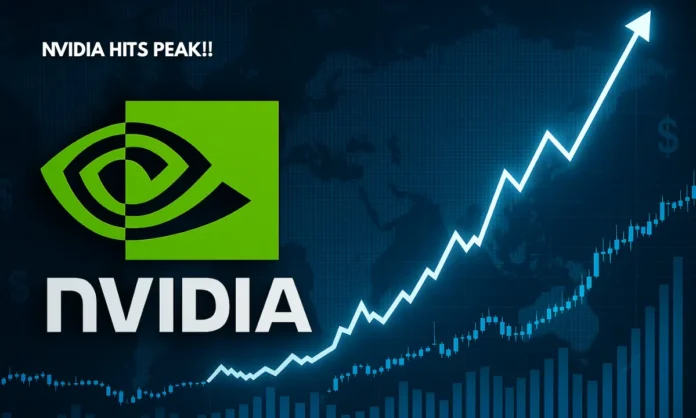SUMMARY
- Nvidia hits $3.92 trillion valuation, surpassing Apple’s all-time record and nearing a historic $4 trillion milestone.
- Fueled by insatiable demand for AI chips, Nvidia is now more valuable than all UK-listed companies combined.
- As AI arms race heats up among Microsoft, Meta, and Amazon, Nvidia becomes Wall Street’s barometer for the next tech age.
Silicon Ascendant: How Nvidia’s AI Chips Rewired the Global Market Hierarchy
On July 4, 2025, Nvidia came within a breath of rewriting Wall Street history. The Santa Clara-based chipmaker’s market capitalisation surged to $3.92 trillion, overtaking Apple’s December 2024 record and inching toward a symbolic and financial milestone: becoming the most valuable company in human history. At $160.6 per share—up 2.2% in intraday trade—Nvidia’s upward trajectory was powered not just by numbers, but by the collective conviction of global markets: AI is the future, and Nvidia is building its brain.
The company’s transformation from a niche GPU supplier for gamers into the foundational hardware provider for generative AI, data centers, and machine learning platforms has redefined the tech landscape. From Microsoft’s $3.7 trillion valuation to Tesla’s data-center pivot, every major player is chasing the AI wave—and Nvidia is their silicon supplier of choice.
The numbers are staggering. Nvidia is now worth more than the entire Canadian and Mexican stock markets combined, according to LSEG data. And as analysts rush to revise earnings expectations upwards, Wall Street is learning a new lesson: stock prices are volatile, but revolutions are exponential.
$NVDA
— WallStTitan (@BullMarketBoss) July 1, 2025
Nvidia is closing in on hitting a $4 trillion valuation and the pace is staggering:
$1T in June 2023
$2T in 262 days
$3T in 96 days
$4T potentially soon?
This isn’t just market momentum. It’s the reshaping of tech dominance.
AI isn’t the future, it’s now, and Nvidia is… pic.twitter.com/MxXe27GTJT
The Anatomy of a Market Superpower
- Nvidia’s stock has risen 68% since April 4, recovering from a brief dip triggered by global tariff fears.
- Its P/E ratio of 32x—down from its 5-year average of 41x—signals that earnings are growing even faster than the stock.
- Nvidia now holds a 7.4% weight in the S&P 500, the highest for any single stock in the benchmark index.
- Insiders have reportedly sold over $1 billion in shares amid the ongoing rally.
Despite fears of overheating, Nvidia’s surge appears to be fundamentally driven, not just sentiment-led. While many stocks rally on speculation, Nvidia is rallying on demand visibility—Microsoft, Meta, Amazon, and Alphabet are collectively spending tens of billions on AI infrastructure, nearly all of which is powered by Nvidia’s GPUs.
This isn’t just about one company’s outperformance. It’s about an entire technology cycle restructuring around compute-intensive intelligence, and Nvidia, co-founded by CEO Jensen Huang in 1993, happens to own the most critical component.
AI Arms Race: Why Nvidia’s Chips Became the Battlefield
- Microsoft, Meta, Tesla, and Amazon are all building massive AI supercomputers powered by Nvidia chips.
- Chinese firms like DeepSeek triggered early-year jitters with low-cost AI rivals, but Nvidia’s high-performance edge is still unmatched.
- The November 2024 addition of Nvidia to the Dow Jones, replacing Intel, cemented its status as the new face of semiconductors.
Nvidia’s rise comes amid a global scramble for AI dominance. In a world where intelligence is becoming the most valuable commodity, access to compute power is as strategic as access to oil once was. Nvidia’s latest chips—like the H200 and B100—are essential for training and deploying the large language models that power services like ChatGPT, Gemini, and Copilot.
And this isn’t just about data centers. Autonomous vehicles, quantum simulators, medical imaging, financial modelling—every high-value sector is being rewired by generative AI. With Intel struggling and AMD playing catch-up, Nvidia has seized both the supply chain and mindshare needed to lead this revolution.
Wall Street’s Golden Child—Or an Overpriced Oracle?
- Nvidia’s valuation eclipses all publicly listed UK companies combined.
- Yet its 32x forward earnings multiple is seen as “modest” by analysts, considering past 5-year averages.
- Still, insider sales and softening demand fears from China may loom over its continued ascent.
Critics warn of excessive exuberance. Some cite the recent insider selling—over $1 billion offloaded by top executives—as a sign that Nvidia might be nearing a short-term top. Others point to China’s rapid entry into the AI chip race, with startups like DeepSeek offering competitive models at lower costs.
But the numbers say otherwise—Nvidia’s earnings are catching up with price. For now, it trades at a lower multiple than many of its peers despite growing eightfold since 2021, when its valuation was $500 billion.
The company’s challenge will be sustaining demand in a crowded AI hardware market while continuing to deliver new innovations at scale. But if history is a guide, Nvidia thrives under pressure—and has already shown it can outrun rivals in both speed and strategy.
The Chip Heard Round the World
Nvidia’s near-$4 trillion valuation marks more than just a stock market feat—it’s a geopolitical and technological turning point. The center of gravity in global innovation has shifted to data, compute, and model training—and Nvidia’s chips are the architecture of that shift.
What Apple was to consumer hardware, and what Microsoft was to software ecosystems, Nvidia is becoming to AI: indispensable, irreplaceable, and immensely valuable. Jensen Huang may have started out building graphics cards for video games, but in 2025, he may be leading the most powerful tech company ever conceived.
The question is no longer whether Nvidia deserves this valuation. The question is whether the rest of the world can catch up.


